The world is dominated by social networks.
They are the go-to place to get informed, see family photos, connect with old friends, discuss the trends of the day, and, of course, follow brand news.
It’s also the holy grail for Digital Marketing.
That’s why social media marketing is essential for businesses to communicate and engage with their audiences.
Brands need to be present on major networks such as Facebook, Instagram, LinkedIn, and, more recently, TikTok.
Each social platform, with its distinctiveness, audiences, formats, and way of communicating, offers different possibilities for brands to explore.
It’s important to understand their capabilities and how they can help your brand build a Digital Marketing plan that is aligned with your business mission.
Follow this guide to better understand how to utilize Social Media Marketing and how to generate the best results from each platform.
What is Social Media Marketing?
Social Media Marketing is the combination of strategies to promote a brand online so it can achieve both general and specific marketing goals.
It means finding your audience on social networks and working to introduce your brand into their everyday lives.
That way, it becomes well-known and relevant to a specific public.
It also raises engagement on said platforms and attracts more potential clients, inclined for conversions, raising your sales.
Although many people, even professionals, think about Social Media Marketing as publishing posts in a feed, being successful in that area requires a lot of other activities:
- Planning
- Content production
- Interactions with followers and general audience
- Ads investment
- Monitoring
- Strategy optimization
These are the pillars of Social Media Marketing, ones that will help you structure your presence online.
To have real, consistent results, your work needs to cover each of these.
Why do you Need to do Social Media Marketing?
Since the creation of social media, this format has become a major part of the marketing plans of any kind of business.
Social media has brought brands and audiences closer than ever and transformed customer-brand communication.
This scenario was a revelation for companies that found a whole range of benefits coming from this more direct communication.
Let’s take a look at the main advantages that social media marketing is bringing to brands all around the world.
Raise engagement
Social media is unique from other marketing channels because of the power of interaction and subsequent (and ongoing) engagement.
The customer will always be a passive viewer when consuming a TV ad or a billboard, for instance.
But on social media, they can click, like, comment, share, and reply among a variety of possible interactions.
In theory, the customer remains close to your brand every day, with little, almost imperceptible interactions every time they use those platforms.
Social networks allow your company to raise engagement and build stronger bonds with the audience. A community is created around the brand.
Raise the brand’s reach
There are more than 4 billion social media users in the world. This number represents almost half of our total population.
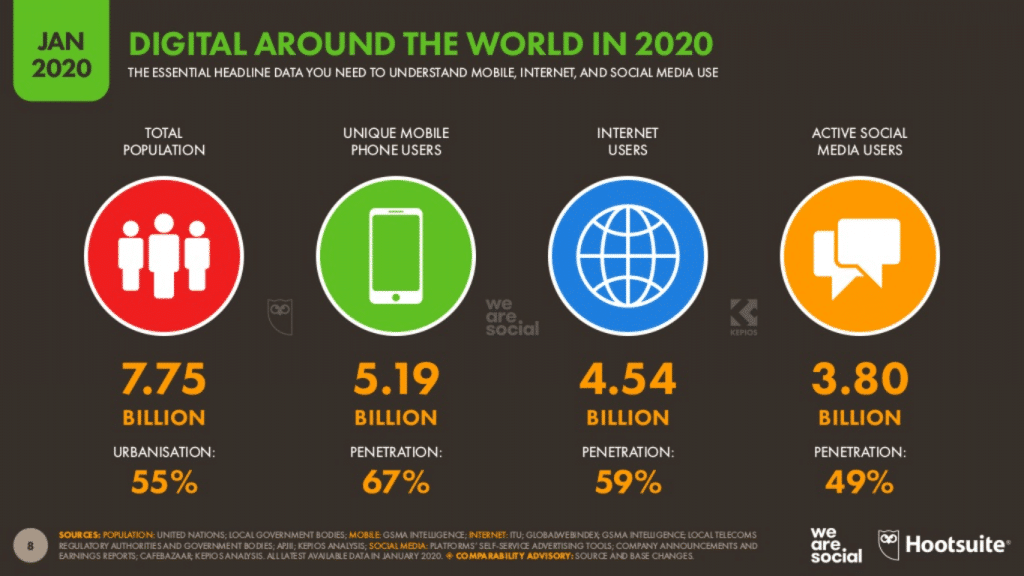
These incredible numbers show us the main reason why businesses are investing so much in social media: to be visible to as many people as possible.
And why keep things local?
Providing great results in your neighborhood, city, and country opens doors to the entire planet through the internet.
Humanize the brand
Social networks are opportunities to show what your brand is about to people; showing it’s more than just a product and a price.
You can use it to present backstage content, use more approachable, friendly language, and position yourself more as equal to all other users.
On social media, brands can imprint a personality of their own. This can be achieved when brands share their values, attitudes, and principles.
Showing this in your content enables your brand to become less mechanical or cold, promoting a more humane and authentic interaction.
Generate more traffic and conversions
Even with the word “social” present, these networks aren’t just about building an image for your brand.
Until now, we have seen how they help companies increase reach, engagement, and authenticity. But they can also contribute directly with stages deeper in the buyer’s journey.
After all, social media is the perfect channel to attract and lead your potential customers to richer content.
This is an opportunity to highlight blog posts, interactive content, conversion sites, digital products, your brand’s contact page, and so on.
Some networks also offer now the possibility of selling products inside the platform itself, cutting corners and raising your selling odds. For example, restaurants can attract more customers by allowing them to order food directly on Facebook using their ‘Start Order’ call-to-action button.
Followers today are always potential customers.
Know your audience better
This close relationship between brand and customer is not only about them knowing you, but you getting to know them better, too.
You can use these interactions to talk to people, find out what they like, and what motivates their engagement.
The platforms offer rich data about the audience following your brand, like age, gender, location, working status, interests, etc. These are crucial when you build your buyer persona.
You can even know how they relate to your brand by monitoring mentions and shares with your name on them.
It is always good to know how they perceive your company so you can adjust your strategy accordingly.
Fine-tune ads segmentation
Combining ads with your knowledge of the audience is a powerful way to improve your conversion rate.
These platforms offer some kind of advertisement plan based on Big Data.
With all the information they gather from users, they allow you to fine-tune ads so you can reach exactly the audience you want.
That way, your investment in marketing becomes more efficient and brings more in return.
How to Conduct Marketing on Social Media?
For a long time, brands were seen as intrusive on social media. After all, these platforms were built initially to connect people, not businesses.
But, with time, social media had the opposite effect.
Now brands are part of people’s lives and they want to know everything about the products they consume.
This relationship is even encouraged inside the networks, as they are a way of monetizing the whole ecosystem.
It’s safe to say that nowadays these social networks couldn’t exist without brands being present.
But only the ones that understand the media and plan with intelligence can reach success in such a competitive field.
This means a specific strategy for each channel is needed to reach your goals.
So, next, you will see the best tips to make an efficient social media plan, structure your presence, and reach a bigger audience. Check it out.
1. Define your social media marketing goals
Your first step to finding a path to success is to define where you want the journey to take you.
Social media today can help you reach a variety of objectives including:
- Raising the brand’s reach and awareness.
- Raising engagement with the brand.
- Directing more organic traffic to your website, blog, or e-commerce.
- Generating leads.
- Raising overall sales.
- Building a community around your brand.
- Improving customer service (CS).
- Monitoring the buzz around your brand.
Pick one or some of the goals in this list to start your planning. What you want for your brand is what will direct your decisions from now on.
Also, when those marketing goals are defined, research metrics and KPIs you should be monitoring to be sure you are following the path traced.
If you want more sales, for instance, you should follow numbers on conversion and loyalty rates.
2. Build a buyer persona for social media marketing
The buyer persona is one of the most important Social Media Marketing pillars.
You probably already have a consolidated target audience, right? For example, you know you need to talk to women aged 18 to 35 that live on the West Coast and like athletics.
But have you considered:
- How to engage with them?
- Which channels do they use to be informed and to connect with other people?
- What kind of content do they consume (text, video, audio, etc.)?
- What’s the time of the day they use social media?
- What kind of interests do they have that you can address?
- What are their doubts and difficulties in life?
- How can your product, service, and/or expertise be useful to them?
These are the questions you need to answer to build a semi-fictitious profile of the company’s ideal customer.
All your content will be talking to this character.
Although the target audience concept is important to your marketing decisions, in this context it is superficial and it doesn’t go deep into how humans connect and interact.
On social media, your brand is trying to be perceived in the same manner as a person. So you need this knowledge to understand how to talk and behave like one inside a niche or a specific demographic.
The buyer persona can give you that nuance.
(Are you interested in building one? Try out our persona generator!).
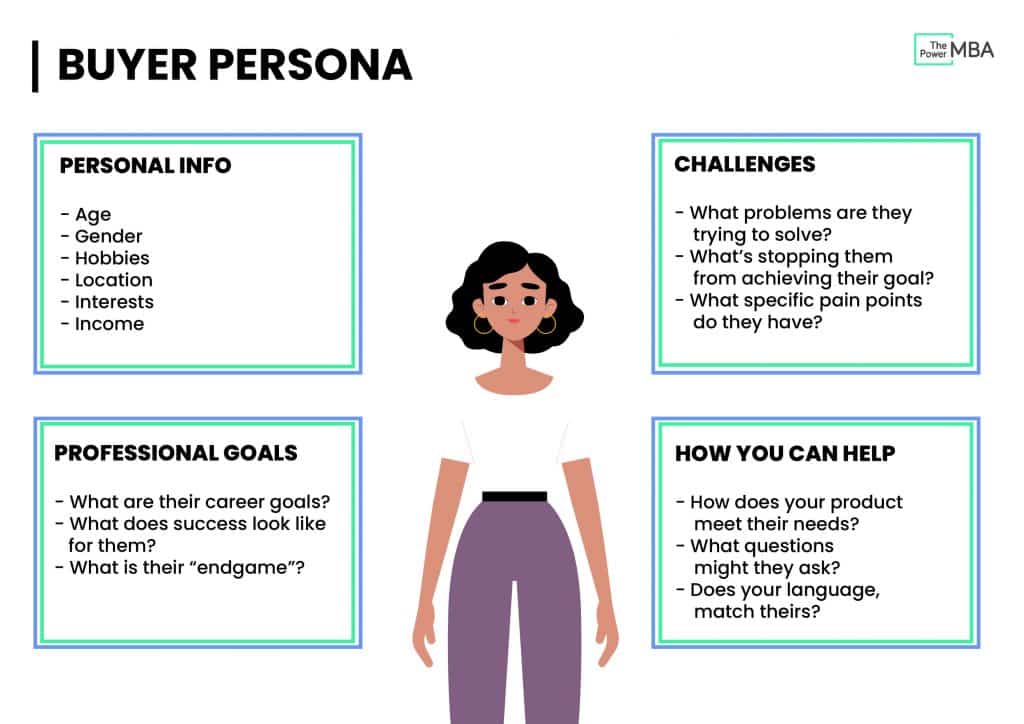
3. Prioritize the networks that fit the brand better
Although it is advised to be present on as many of them as possible, you don’t have to — and usually can’t — divide your attention equally among each network.
Managing so many profiles at once demands time, people, and resources that you probably won’t have.
And even if you did, it is an inefficient approach, as your target audience probably doesn’t use all of the platforms.
In the end, dividing your efforts will result in subpar returns on all of them.
But, it is your job to find the most appropriate social media for your brand — the ones that fit your audience’s profile, your team’s capacity, and your marketing goals.
4. Plan both paid and organic strategies
The majority of social networks started just with organic material. Publishing relevant content was enough to make a profile reach all followers and beyond.
But when these platforms became popular, they started using different algorithms.
Since then, social media prioritizes the posts that it considers more relevant to each person in its feed or timeline.
In this context, it becomes harder for a brand’s posts to shine. As a result, companies that want to raise organic reach now have to invest in marketing.
It is the formula for growing numbers on social media, and the brands that don’t play the game tend to stay behind.
Businesses that really want to thrive on social media should reconcile both organic and paid strategies.
Organic content is made frequently and creates daily contact with the brand, keeping followers informed and engaged.
Paid content should be on point and aim at specific segments of the audience to achieve pre-set direct goals.
Combining these two approaches is important because one can support the other.
Organic posts bring consistency and online presence while paid posts focus on acquiring new leads and being seen by new audiences.
5. Create unique and relevant content for your persona
Creating relevant content is the best way to bypass the limits of organic reach.
After all, relevance is what makes something appear on a user’s feed or timeline. The goal of social media is always to quickly and effectively draw attention.
Content production should aim at defined points to increase reach and engagement naturally.
Your content must be original, aligned to the persona, and adequate for what is best suited to each network. It can educate, inform, entertain, and advertise special offers.
Brands can’t and shouldn’t only talk about products and discounts.
One idea is to follow the Pareto Principle or 80/20 rule: only 20% of the content should talk about what the brand sells.
The other 80% should approach subjects surrounding your field, answering interactions started by the persona.
But remember that all of that depends on your audience. It is a good idea to make some tests to know how your followers react to each type of post.
6. Create an editorial schedule
An editorial schedule will help you organize and control the brand’s activity on social media.
It brings projections like publishing frequency (weekly, monthly, quarterly), as well as the processes of producing, scheduling posts, and generating reports, among other possibilities.
Brands can establish and maintain a pace on social networks.
This is essential for algorithms to consider your profiles active and keep showing your posts to your followers.
An editorial schedule gives you a big picture. During a month, for example, you can plan 16 educational/entertaining posts and 4 promoting posts on Instagram, giving you an 80/20 balance.
7. Follow performance indicators
Brands can’t use social media marketing without constantly checking indicators.
With the right metrics for social networks, you will find ways to continually improve your strategies toward better results.
Remember when we discussed the goals for social media when we cited the importance of getting the right KPIs for your marketing plan?
That alignment between what you measure and what you want to achieve is the best way to do it.
Just try to avoid keeping track of vanity metrics, those numbers that seem impressive at the surface.
The number of likes and followers, for example, doesn’t necessarily translate into real marketing goals.
The most important KPIs are those that directly help your audience find your product and become loyal to your brand.
What are the Main Social Networks for Marketers?
Now, let’s go deeper into the subject and better understand the main platforms for social interactions and social media marketing.
You’ll have a broader view of their main particularities, the profile of people using them, and the kind of content that works better on each one.
Facebook is still the most used social network in the world: around 2,9 billion users are active monthly. So, it is naturally the one with the biggest reach for brands.
But there is a growing perception that Facebook is being left aside by younger generations who are migrating to more visual platforms such as Instagram and TikTok.
While many groups converge on Facebook, the network is used mostly by adults: Generation X (born between 1960 and 1980) and Millennials (born between 1980 and 1995).
But Facebook isn’t just a social network. It is a great platform for business, with features aimed at companies.
It is possible to post content in multiple formats, receive and manage messages easily, get user scores, stream live events, etc.
If you produce relevant content, aimed at your persona, and with adequate frequency, reaching more organic traffic is very doable. But it is also true that your organic reach is limited.
In 2020, the average reach for organic posts on Facebook (in relation to the total of followers) was 5.17%. It was 6% in 2019 and the number doesn’t stop falling. On the other hand, the percentage of pages using paid media is growing, as you see below.
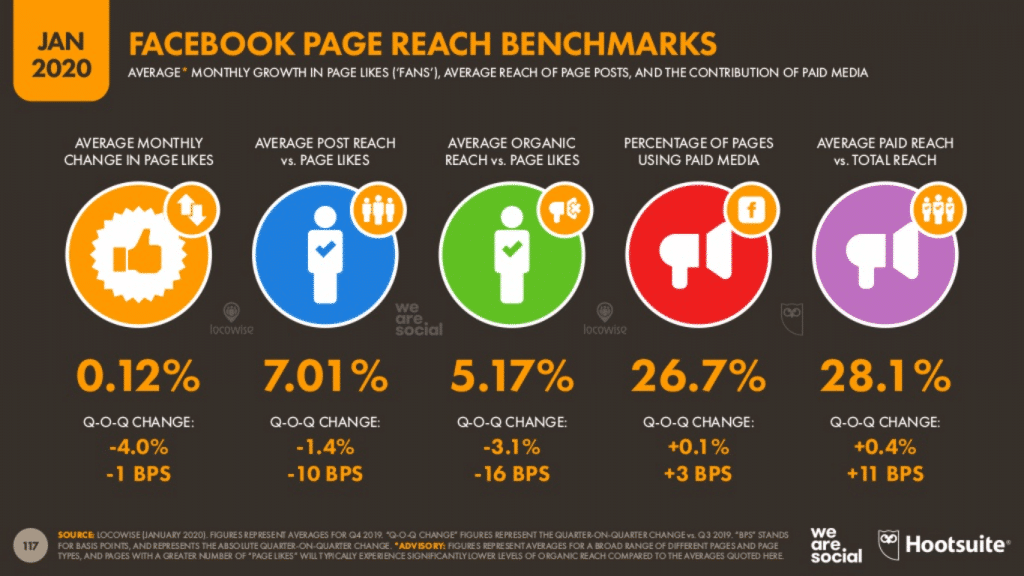
So, to take advantage of Facebook’s full potential, it is important to also invest in ads.
Facebook Ads is a powerful tool for marketing, with a lot of resources for segmentation and campaign goals.
It is even possible to advertise websites from partners, not just inside the network.
You can also develop a strategy for Facebook Groups that gather people with common interests.
Consider creating a group for your brand or just for special clients, and also participating in discussions with players in your market’s segment.
Instagram was the first social media to break Facebook’s omnipresence — not coincidentally, it was bought by the giant right after it became a success.
Today, it is one of the biggest, with an estimated number of 1.4 billion monthly active users.
If Facebook is aging, a big chunk of that younger audience migrated to Instagram. In 2020, around 70% of the users were 35 years old or less.
It is mainly inhabited by the Millennials searching for lighter, more authentic, visual, and dynamic content.
Instagram began as a network focused on publishing photos of users’ daily lives.
With time, it gained new features, like publishing videos and carousels, creating stories, live streams, videos for IGTV, and, most recently, reels. Their innovation is constantly evolving.
One of Instagram’s stand-out particularities is its vocation to selling.
Instagram has shopping features like tagging products on posts and recently launched an exclusive tab called Instagram Shop, to discover new products directly on social media.
When focusing on this network, it is also important to consider the combination of paid and organic posts.
Your constant, special content will engage and retain the audience, while the ads reach a new public and help you achieve specific marketing goals.
YouTube
Some people still don’t think of YouTube as a social network but in fact, is the second most frequented in the world.
There are more than 2 billion users monthly active on the platform.
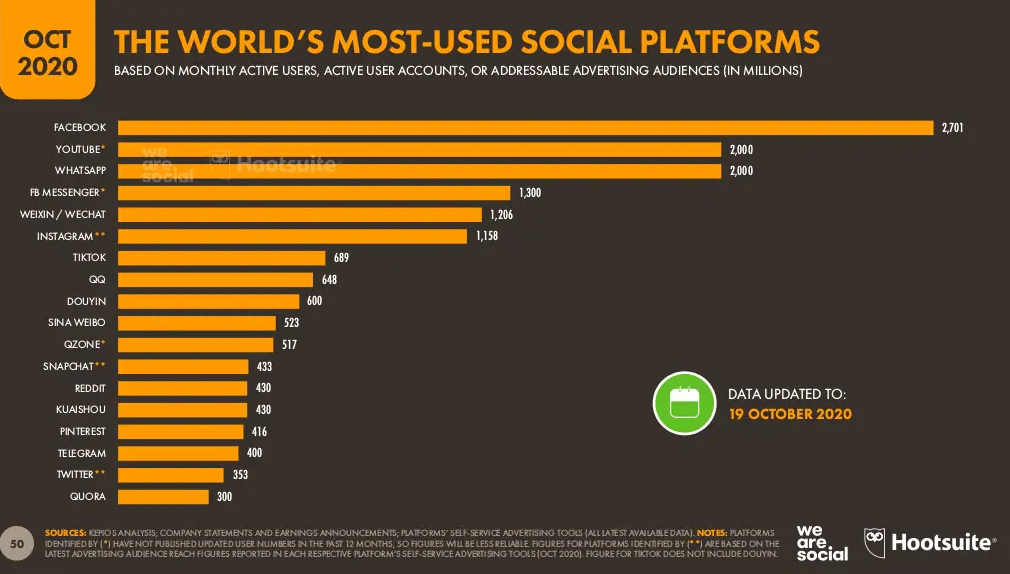
YouTube is the main social media for video in the world. And you know that Video Marketing is stronger each year, right?
Multimedia content shows high potential for engagement. That is why YouTube should be part of your marketing plan with a solid strategy to present video content.
You can use it to share institutional videos, interviews, tutorials, and testimonials, do live webinars, or create a series of branded content.
If you don’t want to create your own channel (although it is highly advised) you can still include YouTube in your strategy by doing partnerships with known YouTubers in your niche or creating video pieces for Google Ads.
Red Bull is a great example of a business that does it right.
The company invests in creating awesome video content while highlighting marketing pieces with branded content related to extreme sports, racing, and e-sports.
Twitter is not among the most used social networks in raw numbers but has an active and loyal user base.
Recently, the platform reached 350 million users worldwide. A curious point is that the majority of Twitter’s audience is male: 68% in 2021.
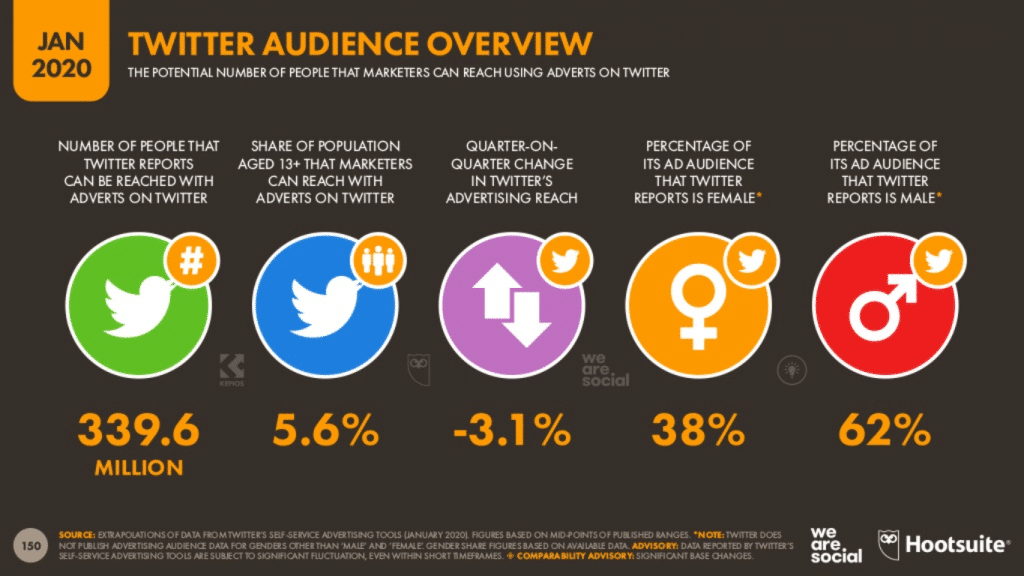
Twitter became popular as the 140-character social media. Nowadays, the limitation is at 280 and posts allow other types of media such as photos, videos, and polls.
The people on Twitter like to be informed of the last news, give opinions on the day’s buzz, and participate in what is happening in real-time — the trending topics.
Companies that want to use marketing on the platform need to follow these dynamics.
You can post news about the brand, be a part of conversations in your segment, take followers to your website, and even conduct direct customer service as many users post their complaints and doubts about a product.
Netflix is a case for Digital Marketing as they excel on Twitter.
They frequently bring news about shows there first, participating in conversations and joking with users viewing their catalog.

LinkedIn has almost 800 million active monthly users.
It is an impressive number for a social network with a very specific scope: to be a platform for professional connections.
For businesses wanting to produce marketing on LinkedIn, it is crucial to understand that people are mainly there for that.
It is a great place to attract leads (especially for B2B) or attract the best talent to work with you.
Showcase your company, give career tips, feature your team, and show your organizational culture.
LinkedIn also allows you to contact users directly: you can use InMail messages to prospective clients and approach candidates for an open spot.
Besides that, you can use LinkedIn Premium’s paid tools, such as Sales Navigator to manage leads or Recruiter, to promote jobs and recruit talent.
Amazon, for example, uses LinkedIn to show its backstage, from managing offices to distribution centers. It is a way to humanize the brand and show the values that guide your culture.
TikTok
TikTok is the new kid in town, the social network that exploded in popularity in 2020.
Boosted by the limitations we had to go through during the pandemic, the network already has 1 billion active users globally.
Those who enter TikTok for the first time quickly realize that the platform is dominated by GenZ, born between 1995 and 2010. Younger audiences love how dynamic the platform is.
That means brands need to understand that language to thrive there.
TikTok is a network of short videos, dances, challenges, lip-sync, filters, duets, and anything that exercises creativity.
Videos on TikTok don’t need to be perfectly polished to go viral.
Actually, the ones that get more engagement usually are not that well-made or have amazing image quality. What matters is to be creative and original.
TikTok grew so fast that brands are still trying to find the best ways to turn their engagement potential into real Marketing success.
The Photo Studio, an Australian company, is one of those that are cracking the code.
They used the collaborative aspect of social media to make a contest for young Australians, resulting in a conversion rate of more than 10%.
Pinterest was always kind of the outlier of social media.
It was never the most popular network nor the most spoken about, but it really engages its loyal audience: 442 million users, 60% women.
That happens because Pinterest really is different.
While it offers interaction tools, it is a more visual search engine than a social network.
People use it to create inspirational boards for their lives, jobs, or projects. They are looking for references, keeping recipes saved for special occasions, planning their living room’s decoration, or researching new looks.
This behavior means that Pinterest has deeper ties with consumption than other platforms, as people usually use it to plan purchases.
According to the brand, 85% of its users say they access the channel to start new projects, while 89% say they access it as an inspiration to buy something.
Your company can use Pinterest to share pins based on your persona’s lifestyle, reinforcing your brand’s personality and inspiring users.
Brands can also use Pinterest to drive sales: pins can redirect the lead to your website or eCommerce, generating more organic traffic and converting more.
Sephora is an example of a company to study, with almost a million followers.
Wrap Up: Social Media Marketing is Vital for Your Success
Now that we have introduced you to the main ways to do social media marketing, it is your turn to experiment, test your audience and evaluate which platforms work better for you.
The main goal is to align your strategies with your audience’s expectations and your marketing goals.
Social media can be your ally to attain greater reach, engagement, and conversions.
Finally, one thing almost every social network has in common today is the way video engages and goes viral.
To help you plan this type of content, check our exclusive Video Content Template for social media!
2024 State of Marketing Report
Your golden ticket to crush your goals with data-driven insights!
2024 State of Marketing Report
Your golden ticket to crush your goals with data-driven insights!

![[Rock NA] State of Marketing Reports 2024 – Comkt Hubspot State of Marketing Report 2024](https://rockcontent.com/wp-content/uploads/2022/07/Banner-Fino-Rock-Convert-2500-%C3%97-500-px-19.png)







